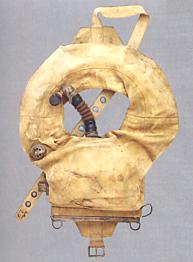

|
Escaping from a Sunken U-Boat
There can be no doubt that U-boats dealt out death and suffering to many sailors, and many of their victims died under horrible circumstances from burns, wounds, exhaustion and drowning. By the same token, U-boat crews themselves suffered horrible deaths with many U-boats sunk with all hands on board. Many were trapped when their U-boat plunged out of control into the depths of the ocean and unable to rise again. The horrors of the pressure hull creaking and exploding under the pressure of the ocean depth is perhaps matched only by the grim situation of being trapped at the bottom of the ocean with the air supply running out. Many crews must have perished one by one as they lay trapped inside their boats.
During submarine school, U-boat crews were trained to deal with every combat situation. And that included the grim task of escaping from a sunken submarine. Underwater escapes were rare, although it is known that men often survived for lengthy periods in sunken U-boats.

|

|
| Undergoing training with the Drager apparatus. The valve on his right breast is used to expel spent air, while the side valve controls airflow from the oxygen canister. | Closeup of the Drager apparatus. The mouthpiece is clearly visible. |
The escape equipment used for an underwater escape was primitive by today’s standards. Known as the Drager apparatus, it was a simple device which functioned as an artificial lung. It consisted of a tube attached to a face mask, an oxygen canister, a canister filled with carbon dioxide absorbent materials, a control valve and the entire apparatus was fitted inside a special vest, so it could be worn like a life jacket. To obtain air, the oxygen valve had to be opened, inhaled and then exhaled through a small vent in the face mask. Air was recycled so it functioned as a re-breather. There was a special valve which had to be manually opened to expel used air when carbon dioxide had accumulated to high levels. The Drager apparatus was meant to be used for underwater repairs and escapes up to 400 feet, although none had ever survived at that depth.
However it was impossible to open the escape hatch underwater, as the sea pressure pushing against the hatch would have jammed tight the hatch and the controls. The boat interior had to be flooded first by opening the flood valves. When the interior was fully flooded with sea water, thereby equalizing the interior and exterior pressure of the boat, then the hatch could be opened. Another hazard lies with the boat’s batteries. When exposed and mixed with sea water, it emitted a poisonous chlorine gas. Many U-boats were forced to the surface and abandoned when sea water seeped into the boat’s battery casings which had cracked under a depth charge attack.
One of the more remarkable escapes took place on January 21 1945. The U-1199 (Nollmann) had plunged to the bottom of the ocean, unable to surface. At 73 meters underwater, a petty officer managed to open the conning tower and reached the surface using his Drager apparatus. To this day, this harrowing escape remains as the deepest known operational escape from a submarine.
On October 3rd 1942, U-512 (Schultze) was attacked and sank to the bottom at 43 meters. When seawater reached the batteries, the crew collapsed after inhaling chlorine gas. But three managed to escape using the Drager apparatus. One survived.
October 16 1943 saw U-533 (Hennig) trapped at the bottom of the ocean after an attack by a RAF Bisley. Three crews managed to remain calm when the interior was flooded. They worked to open the hatch and reached the surface. In the event, one became unconscious on the way up and died shortly afterwards, the second died an hour later while the third survived. He drifted for 30 hours in the sea before reaching land. None of them had used an escape apparatus.
Another incident involved U-526 (Moglich). After an operational patrol, the U-526 was on its way back to Lorient when it struck a mine. Twelve men who happened to be on the upper deck survived, although nine were seriously wounded. But the U-boat sank to the shallow bottom with the rest of the crew. As it was in shallow waters, divers were sent down in a rescue operation. They managed to ascertain that there were survivors inside, but the hatch housing were so twisted due to the force of the explosion that they could not be opened. Everyone trapped inside perished.
Some escapes were more straightforward. On August 20 1944, U-413 had bottomed at the English Channel at approximately 27 meters. The Leading Engineer went forward to investigate the damage when an air bubble blew him out of the boat and safely onto the surface.



